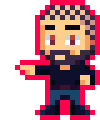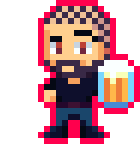Hanging on Balloons
One of the best things you can do for yourself in gamedev is to have good tools and an efficient workflow. I’ve already shown how I handle path movement in [Speer] in another post, now I want to show you another small trick I’m using to make level creation easier and quicker.
Note: As always this article will show how I’ve implemented it in HaxeFlixel, as that is the framework I’m using. The general idea however is framework-agnostic and can be implemented anywhere.
[Speer] features balloons that carry various items around the stages:

I’ve coded this system to be flexible, so as long as an object inherits from a certain class, it can be attached to a balloon and will be updated automatically. But how do I actually attach items to balloons? Well, the most intuitive way would be to actually, physically attach an item to a ballon, wouldn’t you say? I would, so that’s what I did. Enter hookUpBallons():
private function hookUpBalloons():Void{
grpBalloons.forEach(function(B:Balloon){
grpBalloonables.forEach(function(C:Balloonable){
if (B.tileCoords.x == C.tileCoords.x){
if (B.tileCoords.y == C.tileCoords.y-1){
B.assignItem(C);
}
}
});
});
}
This one might require some explanation. When the map data is parsed ( using HaxeFlixel addons, see this post for more info ) every Balloon that is created gets added to the Group grpBalloons. A Balloonable is an instance of a class that can be attached to a balloon, and those are saved in grpBalloonables.
Once all entities have been instantiated and added to their respective groups, I call hookUpBallons() in my PlayState. The function then loops through all Balloons and all Balloonables and checks their position in the tilemap; if the Balloonable is one tile below the Balloon, it gets attached to that balloon. Note: tileCoords is not a HF-internal property, but it basically just takes an object’s x and ypositions and converts them to tile coordinates in the current map.
So when I position the items like this…

…then the items will be attached to the balloons in-game:

However, if I move an item just one tile to the right…

…it’ll fall down as soon as the game starts:

And that’s pretty much the whole secret. This way I don’t have to set any IDs or explicitly make any connections. I can just intuitively do what I want done: Attaching an item to a balloon. It’s little things like this that make game design not only more efficient but also more fun.

Want To Buy Me a Coffee?
Coffee rules, and it keeps me going! I'll take beer too, though.

Related Posts
Go! Go! Pogogirl Is Coming to Mega Drive!
It is finally happening: Go! Go! PogoGirl is coming to the Sega Mega Drive!
Comments
By using the Disqus service you confirm that you have read and agreed to the privacy policy.
comments powered by Disqus

